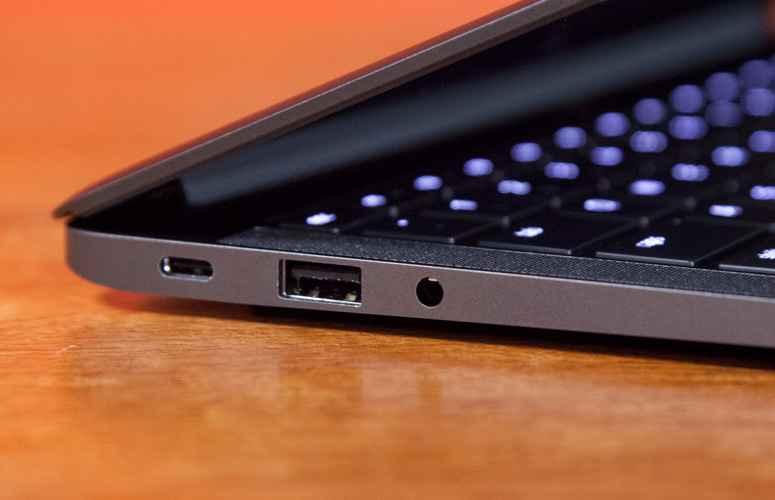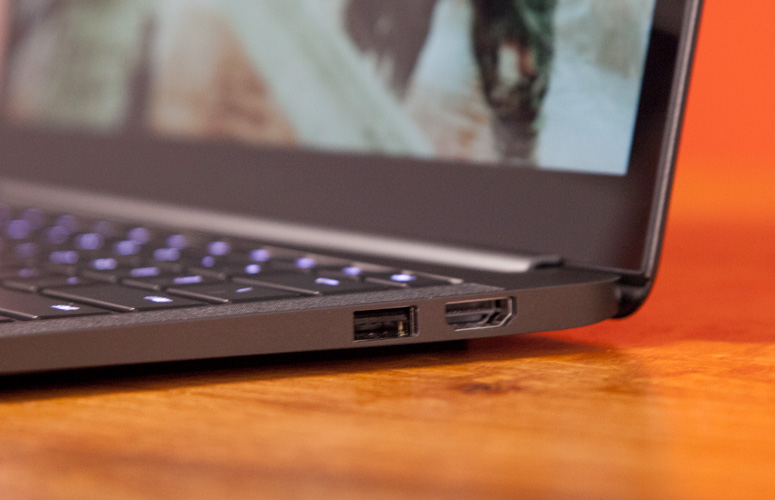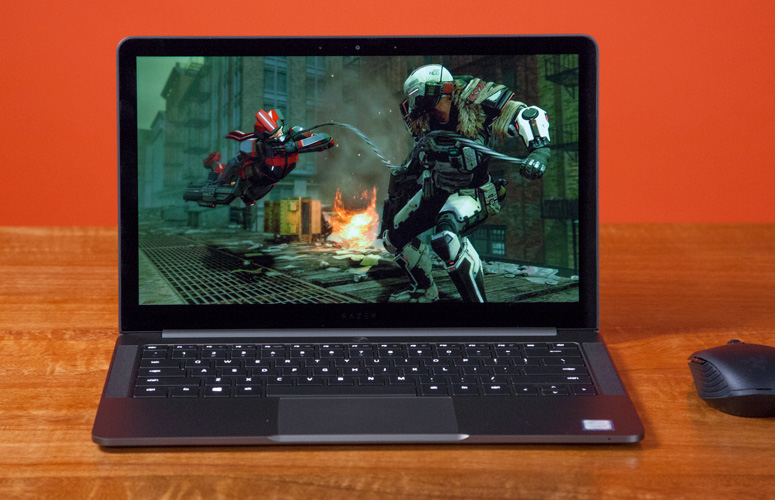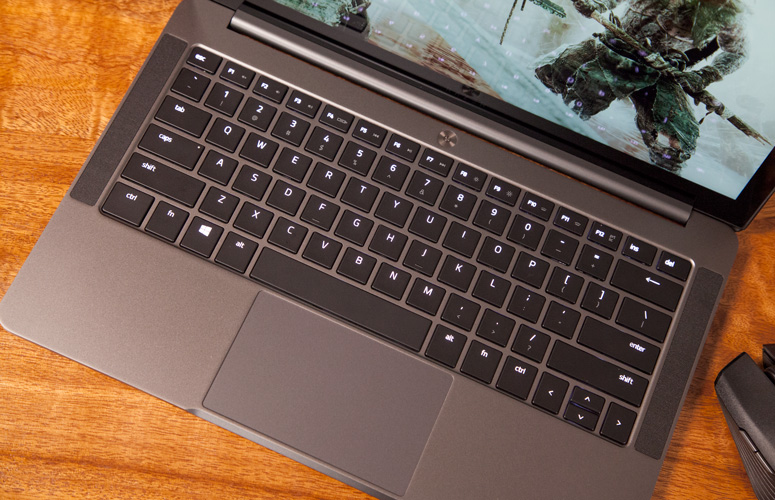Laptop Mag Verdict
The Razer Blade Stealth offers a lovely 13-inch QHD display, powerful graphics and overall performance in a insanely slim chassis.
Pros
- +
Svelte, lightweight design
- +
Great performance
- +
Fast SSD
- +
Bright, vivid quad-HD display
- +
Beautiful, customizable keyboard
Cons
- -
Below-average battery life
- -
Finicky touchpad
Why you can trust Laptop Mag
The original Razer Blade stealth turned heads with its stunningly sleek design and powerful performance, but its 12-inch screen felt a bit cramped. The new Stealth (starting at $1,399, reviewed at $1,599) crams a 13.3-inch display into the same slim and compact chassis. But this upgrade is about much more than just a pretty new screen; this machine is also a productivity workhorse, thanks to its powerful Intel Core i7 processor and integrated graphics. And to further turn up the heat on the competition, Razer's launching a toned-down, gunmetal-gray version of the Stealth for an easier transition from the boardroom to the game room. As svelte and sexy as the Blade Stealth is, it's still held back from true greatness by below-average battery life.
Design
Listen, I understand and appreciate the desire for 12-inch laptops. They're lightweight and easy to toss into a purse or backpack, causing little to no back strain. But I'm also a firm believer that bigger can be better even for ultraportables, which is why I'm crushing on the new Blade Stealth. Measuring 12.6 x 8.1 x 0.5 inches, the Stealth weighs 2.9 pounds; it's only a tenth of a pound heavier than its predecessor.
Compared to other ultraportables -- like the Apple MacBook Pro (13-inch) (3 pounds, 12 x 8.4 x 0.6 inches), Microsoft Surface Laptop (2.8 pounds, 12.1 x 8.8 x 0.57 inches) and Lenovo IdeaPad 710S Plus (2.4 pounds, 12.2 x 8.6 x 0.58 inches) -- the Stealth is slimmer but a bit heavier in some cases. At its slimmest point, the Dell XPS 13 (2.6 pounds) is a barely there 11.9 x 7.9 x 0.3~0.6 inches).
The new gunmetal finish is stately and will look at home in a boardroom.
I imagine there will come a time when I'll grow tired of Razer's look, but for now, I'm still enthralled. Like its bigger brethren, the Stealth's entire chassis is made of a gorgeous black CNC aluminum. The lid is still dominated by the will-'o-the-wisp green, three-headed snake logo poised to strike. The interior consists of the backlit, jewel-like keyboard sandwiched between two slim speakers. The circle button resides on the top, with a large touchpad embedded in the palm rest.
In an effort to appeal to mobile professionals, Razer is offering a gunmetal-gray iteration of the Blade Stealth, a first for the brand. This version of the Stealth places all the emphasis on not standing out. The gunmetal finish is stately, and while Razer's emblem still dominates the center of the lid, it's a subdued black-matte finish that will look at home in a boardroom. This model also swaps out the beautiful Chroma keyboard for a business-professional white backlighting.
Since the Stealth is so slim, there isn't a lot room for ports. Still, Razer managed to fit a USB 3.0 port and a full-HDMI 2.0 port on the right. Along the left, you'll see another USB 3.0 port, a Thunderbolt 3 port and a headset jack.
Sign up to receive The Snapshot, a free special dispatch from Laptop Mag, in your inbox.
Display
The Blade Stealth's display has experienced a bit of a growth spurt, going from 12.5 to 13.3 inches. While I definitely appreciate the larger real estate, I wish the new Stealth's panel were 4K (3840 x 2160) instead of QHD (3200 x 1800). But the glossy panel is still a technicolor wonderland.
Watching the Black Panther trailer, it was hard to pull my eyes away from Michael B. Jordan's handsome face. But when I did, I noticed the intricate lines in his metal chest plate, which offset the Prussian-blue sleeves and olive-green and tan straps. Actress Florence Kasumba was a deadly vision in red as she unleashed a volley of attacks against hostile agents, her floor-length gown undulating in the wind.
Razer's Chroma keyboard looks like a perpetual glitter bomb, and I'm all for it.
Those captivating pops of color are due in large part to the panel's ability to reproduce 121 percent of the sRGB gamut, topping the 100-percent ultraportable average while matching the IdeaPad 710S Plus' showing. The Macbook Pro was a tad better, at 123 percent, while the Surface Laptop achieved 135 percent. The touch-screen version of the XPS 13 hit 105 percent.
The Blade's screen averaged 338 nits on our light meter, beating the 291-nit average as well as the XPS 13's score (318). However, the 710S Plus, Surface Laptop and MacBook Pro were noticeably brighter, at 346, 361 and 458 nits.
MORE: Laptops with the Best Display Brightness
Audio
Bruno Mars' reflective tenor came through loud and clear as I listened to "When I Was Your Man." The soundstage was surprisingly generous and filled my bedroom with warm piano that buoyed the singer's mournful melody. Listening to Kendrick Lamar's "Loyalty," I heard the illusion of bass through the purposefully distorted sample of Bruno Mars' "24K Magic." It's just enough to satisfy most listeners, but for richer audio quality, I'd suggest whipping out the headphones.
The Blade Stealth comes preinstalled with Dolby Audio Plus, which has three presets (Music, Movies and Game) and a custom setting for you to fiddle with. The Music setting should cover most of your needs, but I noticed that Movie definitely expanded the soundstage.
Keyboard and Touchpad
Razer's Chroma keyboard looks like a perpetual glitter bomb, and I'm all for it. Thanks to its bright backlighting, you can see the simmering lettering on the keys clearly even in the darkest room. Depending on what crazy configuration I set up with Synapse, the island-style keyboard was truly a sight to behold.
However, typing on the jewel-toned beauty can take some getting used to. Thanks to the keyboard's 1.2-millimeter key travel (1.5mm is ideal), typing can feel somewhat shallow despite the 70 grams of actuation. Once I got used to the feel of the keyboard, I matched my typical 65 words per minute on the 10fastfingers typing test.
The 4.1 x 2.5-inch touchpad required less of a learning curve. I could easily perform two-finger scrolls and cue up Cortana with a three-finger press.
MORE: Ports Guide
Synapse
In addition to tweaking the keyboard backlighting, you can also set keyboard macros, choose trackpad sensitivity and track your keystrokes with Razer's cloud-based Synapse software. You also have access to the Chroma Apps store, which allows games such as Dota 2, Rise of the Tomb Raider and Overwatch to integrate their unique lighting effects into the game. Best of all, your carefully created masterpieces are saved in the cloud and can be used with other Razer devices.
Performance
Just because it's slim, that doesn't mean that the Blade Stealth is weak. On the contrary, I watched an episode of "The Defenders" on Netflix while running Windows Defender with 15 additional open tabs in Google Chrome, some running Slack, Tweetdeck and streams from Twitch. The laptop's 2.7-GHz Intel Core i7-7500U processor and 16GB of RAM plugged along with no signs of latency.
The Blade Stealth did quite well on our synthetic tests. Its 7,297 score on Geekbench 4 beats the Surface Laptop's showing.
The Blade Stealth also did quite well on synthetic tests, scoring 7,297 on Geekbench 4. That tops the 6,662 ultraportable average. The Surface Laptop and IdeaPad 710S Plus with their Intel Core i5-7500U processors notched 7,157 and 6,497. The XPS 13 and its 6th-Gen Intel Core i5-6200U CPU produced 7,287. The Macbook Pro and its Intel Core i5-7267U processor delivered an impressive 9,213.
When we ran the OpenOffice Spreadsheet Macro test, the Blade Stealth paired 20,000 names and addresses in 3 minutes and 34 seconds. That's much faster than the 5:50 average and beats most competing systems. The XPS 13, for example, finished the task in 4:34.
Thanks to the Stealth's 512GB PCIe SSD is fast, duplicating 4.97GB of multimedia files in 16 seconds, for a rate of 318.1 megabytes per second, cruising past the 221.1-MBps category average. The IdeaPad 710S Plus (256GB PCIe SSD) achieved 282 MBps, while the XPS 13 (128GB SSD) and Surface Laptop (256GB SSD) hit 231.3 and 110.6 MBps, respectively. Equipped with a 512GB NVMe PCIe SSD, the Macbook Pro obtained a blistering 727 MBps.
Graphics Performance
Since it's an ultraportable, the Blade Stealth lacks the discrete graphics cards of its bigger siblings. Instead, the laptop has an integrated Intel HD Graphics 620 GPU, which means that you can play games like Overwatch or BioShock: Infinite, but not taxing titles like Witcher 3 or Mass Effect: Andromeda. For those types of games, you'll need to invest in Razer's graphics amplifier, the $499 Core.
One area where the Blade Stealth still needs to improve is battery life.
In the Dirt 3 benchmark, the Blade Stealth delivered a solid rate of 43 frames per second on high at 1920 x 1080. That's marginally higher than the 39-fps average as well as scores from the MacBook Pro (41 fps, Intel Iris Plus 650), IdeaPad 710S Plus (36 fps, HD Graphics 620) and XPS 13 (28 fps, HD Graphics 620). The Surface Laptop's Intel HD Graphics 620 GPU obtained an impressive 68 fps.
On the 3DMark Ice Storm Unlimited test, the Blade Stealth achieved 73,876, blasting past the 58,038 ultraportable average. The Surface Laptop was a distant second, at 66,947, with the IdeaPad 710S Plus and XPS 13 following, at 61,201 and 49,394.
Battery Life
One area where the Blade Stealth still needs to improve is the battery life. The notebook lasted only 5 hours and 3 minutes on our battery test, which consists of continuous web surfing over Wi-Fi. That's way below the 8:23 ultraportable average, not to mention the times from the IdeaPad 710S Plus (7:07), MacBook Pro (8:40), Surface Laptop (9:02) and XPS 13 (13:49 without touch, 9:11 with touch).
MORE: Laptops with the Longest Battery Life
Heat
After running an HD YouTube video for 15 minutes, we measured key points on the Blade Stealth's chassis. The touchpad and center of the keyboard registered 82 and 88 degrees Fahrenheit. The bottom of the notebook skirted around our 95-degree comfort threshold, at 92 degrees.
Webcam
The 720p webcam on the Blade Stealth captures stills and videos that are grainy, but fairly color-accurate. A couple of test shots I took in my bedroom yielded hues that were a shade or two lighter than the actual article, including my mustard shirt and midnight-blue wall. The wood grain in my headboard was indistinguishable and looked more like stripes of color than unique patterns.
Software and Warranty
Similar to its gaming laptops, Razer employs a super-light touch when it comes to software. Outside of the usual Windows 10 apps, you'll find Twitter, Candy Crush Soda Saga, Asphalt 8, Drawboard PDF and Sketchbook. Killer Control Center and Diagnostics are also preinstalled, so you can manage bandwidth and ensure that your most important apps get priority on your network. For managing passwords, there's Keeper, although our sister site Tom's Guide recommends LastPass or Dashlane.
The Razer Blade Stealth comes with a one-year limited warranty. See how Razer fared on this year's Tech Support Showdown and Best and Worst Laptop Brands reports.
Configurations
I had the opportunity to spend some quality time with the $1,599 version of the Blade Stealth, which has a 2.7-GHz Intel Core i7-7500U processor with 16GB of RAM, a 512GB PCIe SSD and an Intel HD Graphics 620 GPU. The $1,399 halves the storage to 256GB, while the $1,999 model doubles storage to 1TB.
Bottom Line
The Razer Blade Stealth is simultaneously stunning and a bit infuriating. For $1,599, you get one of the slimmest, prettiest ultraportable notebooks in the land. Thanks to its Core i7 processor, the svelte stunner can multitask with the best of them, and its integrated graphics let you play a number of popular titles at surprisingly high frame rates. And if you need more oomph, invest in the Razer Core and watch the spark fly.
But for all that undeniable greatness, the Blade Stealth's battery life remains its Achilles' heel. The MacBook Pro ($1,638) and Dell XPS 13 ($999) offer over 8 hours of battery life, compared to the Blade's mere 5 hours. And the MacBook Pro also offers faster transfer speeds and a bit more performance. However, the Blade Stealth is a strong contender for mobile professionals who want a system that can crunch numbers and baddies.
- Best Graphics Performance
- Laptops with the Best Overall Performance
- Best and Worst Laptop Gaming Brands
Razer Blade Stealth 13-inch Specs
| Bluetooth | Bluetooth 4.1 |
| Brand | Razer |
| CPU | 2.7-GHz Intel Core i7-7500u processor |
| Company Website | www.razerzone.com |
| Display Size | 13.3 |
| Graphics Card | Intel HD Graphics 620 GPU |
| Hard Drive Size | 512GB |
| Hard Drive Speed | n/a |
| Hard Drive Type | PCIe SSD |
| Highest Available Resolution | 3200 x 1800 |
| Native Resolution | 3200 x 1800 |
| Operating System | Windows 10 Home |
| Optical Drive | None |
| Optical Drive Speed | n/a |
| Ports (excluding USB) | USB 3.0, Thunderbolt 3, Headset, HDMI 2.0 |
| RAM | 16GB |
| Touchpad Size | 4.1 x 2.5 inches |
| USB Ports | 3 |
| Warranty/Support | 1-year limited warranty |
| Weight | 2.93 pounds |
| Wi-Fi | 802.11 a/b/g/n/ac |
| Wi-Fi Model | Killer Wireless-AC |

Sherri L. Smith has been cranking out product reviews for Laptopmag.com since 2011. In that time, she's reviewed more than her share of laptops, tablets, smartphones and everything in between. The resident gamer and audio junkie, Sherri was previously a managing editor for Black Web 2.0 and contributed to BET.Com and Popgadget.







